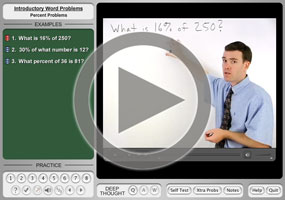Basic "Percent of" Word Problems
Purplemath
When you learned how to translate simple English statements into mathematical expressions, you learned that "of" can indicate "times". This frequently comes up when using percentages.
Suppose you need to find 16% of 1400. You would first convert the percentage "16%" to its decimal form; namely, the number "0.16".
Content Continues Below
Advertisement
Why does the percentage have to be converted to decimal form?
Affiliate
When you are doing actual math, you need to use actual numbers. Percents, being the values with a "percent" sign tacked on, are not technically numbers. This is similar to your grade-point average (gpa), versus your grades. You can get an A in a class, but the letter "A" is not a numerical grade which can be averaged. Instead, you convert the "A" to the equivalent "4.0", and use this numerical value for finding your gpa.
When you're doing computations with percentages, remember always to convert the percent expressions to their equivalent decimal forms.
Once you've done this conversion of the percentage to decimal form, you note that "sixteen percent OF fourteen hundred" is telling you to multiply the 0.16 and the 1400. The numerical result you get is (0.16)(1400) = 224. This value tells you that 224 is sixteen percent of 1400.
How do you turn "percent of" word problems into equations to solve?
Percentage problems usually work off of some version of the sentence "(this) is (some percentage) of (that)", which translates to "(this) = (some decimal) × (that)". You will be given two of the values — or at least enough information that you can figure out what two of the values must be — and then you'll need to pick a variable for the value you don't have, write an equation, and solve the equation for that variable.
What is an example of solving a "percent of" word problem?
- What percent of 20 is 30?
We have the original number 20 and the comparative number 30. The unknown in this problem is the rate or percentage. Since the statement is "(thirty) is (some percentage) of (twenty)", then the variable stands for the percentage, and the equation is:
30 = (x)(20)
30 ÷ 20 = x = 1.5
Since x stands for a percentage, I need to remember to convert this decimal back into a percentage:
1.5 = 150%
Thirty is 150% of 20.
What is the difference between "percent" and "percentage"?
"Percent" means "out of a hundred", its expression contains a specific number, and the "percent" sign can be used interchangeably with the word (such as "24%" and "twenty-four percent"); "percentage" is used in less specific ways, to refer to some amount of some total (such as "a large percentage of the population"). (Source)
In real life, though, including in math classes, we tend to be fairly sloppy in using these terms. So there's probably no need for you to worry overmuch about this technicallity.
- What is 35% of 80?
Here we have the rate (35%) and the original number (80); the unknown is the comparative number which constitutes 35% of 80. Since the exercise statement is "(some number) is (thirty-five percent) of (eighty)", then the variable stands for a number and the equation is:
x = (0.35)(80)
x = 28
Twenty-eight is 35% of 80.
Content Continues Below
- 45% of what is 9?
Here we have the rate (45%) and the comparative number (9); the unknown is the original number that 9 is 45% of. The statement is "(nine) is (forty-five percent) of (some number)", so the variable stands for a number, and the equation is:
9 = (0.45)(x)
9 ÷ 0.45 = x = 20
Nine is 45% of 20.
The format displayed above, "(this number) is (some percent) of (that number)", always holds true for percents. In any given problem, you plug your known values into this equation, and then you solve for whatever is left.
- Suppose you bought something that was priced at $6.95, and the total bill was $7.61. What is the sales tax rate in this city? (Round answer to one decimal place.)
The sales tax is a certain percentage of the price, so I first have to figure what the actual numerical amount of the tax was. The tax was:
7.61 – 6.95 = 0.66
Then (the sales tax) is (some percentage) of (the price), or, in mathematical terms:
0.66 = (x)(6.95)
Solving for x, I get:
0.66 ÷ 6.95 = x
= 0.094964028... = 9.4964028...%
The sales tax rate is 9.5%.
Affiliate
In the above example, I first had to figure out what the actual tax was, before I could then find the answer to the exercise. Many percentage problems are really "two-part-ers" like this: they involve some kind of increase or decrease relative to some original value.
Note : Always figure the percentage of change of increase or decrease relative to the original value.
- Suppose a certain item used to sell for seventy-five cents a pound, you see that it's been marked up to eighty-one cents a pound. What is the percent increase?
First, I have to find the absolute (that is, the actual numerical value of the) increase:
81 – 75 = 6
The price has gone up six cents. Now I can find the percentage increase over the original price.
Note this language, "increase/decrease over the original", and use it to your advantage: it will remind you to put the increase or decrease over the original value, and then divide.
This percentage increase is the relative change:
6/75 = 0.08
...or an 8% increase in price per pound.
URL: https://www.purplemath.com/modules/percntof.htm
Select a Course Below
Standardized Test Prep
Homeschool Math
© 2024 Purplemath, Inc. All right reserved. Web Design by ![]()




